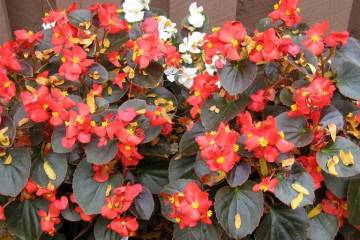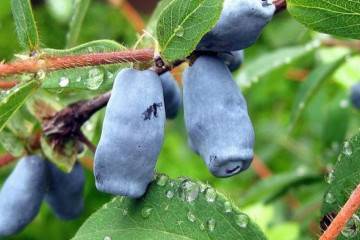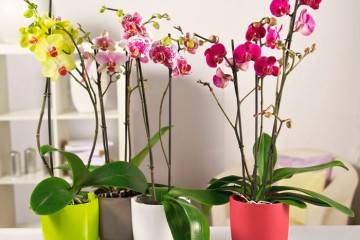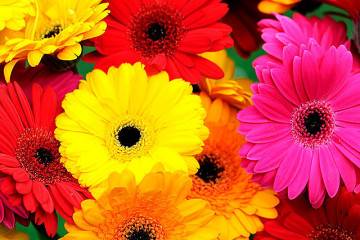Garden chamomile - features of growing at home
Content:
Chamomile is a cute and delicate flower that many growers love. The plant is unpretentious, blooms for a long time and profusely. The flower is easily recognizable as it has a bright sunny core and numerous snow-white petals. Thanks to the variety of varieties, you can easily make a blooming composition that will delight the eye and attract butterflies.
What does a garden chamomile look like?
Garden chamomile, or daisy, has a thin but strong stem 30-100 cm high with two-pinned dark olive leaves. The top is decorated with large inflorescences up to 15 cm in diameter, which are collected from white and yellow flowers without reed and reed.
In the center of the flower is a yellow core. The petals are large, arranged in 1-2 rows. In terry varieties, the petals are arranged in several rows. After flowering, small fruits with cylindrical seeds up to 2 mm in size appear in the center of the plant.
What family does it belong to
Garden chamomile is a perennial or annual plant of the Asteraceae or Asteraceae family. Thanks to the work of breeders, a large number of varieties have been bred, which differ in the size and color of the flower, the height of the bush, and frost resistance.
Briefly about the history of appearance
America is considered the birthplace of chamomile. It was discovered by Christopher Columbus during the discovery of the continent. In Russia, the flower appeared in the 19th century, but it was called belyushka and wedge.
In Egypt, chamomile was considered a medicinal plant, the infusion of the flower had antipyretic properties. The Egyptians believed that the flower was created by the ancient god Ra. The Scandinavians and Germans considered the flower sacred and offered it to the main Deity Odin.
Plant characteristics
Garden chamomile has a number of advantages over the wild specimen. These include:
- large flowers;
- regular bud formation;
- long flowering period;
- re-emergence of flowers in the middle of summer.
Classification of popular species
Chamomile is divided into several types, but the most popular are: meadow chamomile, Kuril daisy, marsh and largest. They are all similar in appearance, but have certain differences:
- flower size;
- place of growth;
- bush height;
- flowering duration.
Meadow chamomile (Leucanthemum vulgare)
Perennial plant up to 90 cm high. The plant forms single inflorescences-baskets with a diameter of 6-7 cm.The marginal petals are snow-white, single-row, with a small lemon-colored core. Blossoming begins in June and lasts about 1.5 months. Grows in meadows and open forest glades.
Kuril daisy (Leucanthemum kurilense)
The plant is small, grows in the east. The Kuril and Japanese islands are considered his homeland. Grows on stones, rocks, sandy seashore. Kuril daisy reaches a height of 20 cm, at the beginning of flowering, a single inflorescence-basket appears on the plant, with white single-row petals and a yellow core. The flower diameter is about 8 cm.
Marsh leopard (Leucanthemum paludosum)
This species grows in the south of Spain and Portugal. The plant has a second name - marsh chrysanthemum. The bush is small, reaches a height of 25 cm. Inclined or erect shoots are covered with rich green, alternate leaves. In early June, the bush is covered with lush inflorescences-baskets, small in size. Flowering lasts until the first frost.
Leucanthemum maximum
A beautifully flowering species that arrived in Russia from the Pyrenees. The plant forms a large number of shoots up to 100 cm and a shortened rhizome. The inflorescences are large, up to 12 cm in diameter. There is a double and semi-double chamomile. The snow-white petals are arranged in several rows, as a result, the flower looks fluffy and resembles a chrysanthemum.
This species differs from others in its late flowering. The first inflorescences appear in the second half of July and last until the first frost. The species has a drawback - it's fragility. Due to the long flowering, the plant spends a lot of energy, as a result, the flower becomes smaller and weaker.
Thanks to the work of Russian scientists, the largest variety of nivyanik was bred - Winner. It is resistant to sudden changes in temperature and long-term flowering. A tall bush forms large inflorescences, 12 cm in size. The variety is unpretentious, growing in one place for about 10 years.
The cultivars that are most popular with horticulturists
There are a large number of varieties of the garden daisy. There are perennial terry chamomile varieties, there are annuals with simple inflorescences. But only a few are the most popular. They differ from each other in the shape of the inflorescences, the height of the bush, the duration of flowering.
Alaska
The most popular large chamomile variety. The plant forms a bush 80 cm high. Inflorescences up to 12 cm in diameter. The variety is unpretentious, drought-resistant. Seeds are planted in open ground in the fall so that the plant will please with flowering next year.
Princess
A low, blooming variety throughout the warm period. The plant forms a small spreading bush up to half a meter high. It blooms profusely and for a long time with regular watering. Bush chamomile, at the beginning of summer the plant is covered with numerous inflorescences 10 cm in diameter. Against the background of short shoots, the flowers look quite large. Flowering lasts about a month, but in order to prolong flowering, it is necessary to cut off the faded inflorescences in a timely manner.
North Star
The cultivar is considered a favorite among perennial garden daisies. The plant got its name from the snow-white-silver inflorescences-baskets with thin, pointed petals. When planted in a sunny place, the bush grows 16 cm wide, and reaches a height of up to 40 cm. The variety is winter-hardy and easily tolerates Russian frosts.
Stern von Antwerp
The giant bush is covered with inflorescences 10 cm in diameter. The core of the flower is yellow, and the ligulate flowers are snow-white. For long-term flowering, the plant is planted in a sunny place with nutritious soil.
Beethoven
A perennial plant up to 80 cm high. In June, single, simple inflorescences-baskets 12 cm in size appear on the bush. Flowers have snow-white petals and a golden core. The variety is suitable for cutting, single and group plantings.
Schwabengrub
The variety forms a huge bush 80 cm high. During flowering, the plant is covered with large, double flowers. The variety is winter-hardy; for fast flowering, it is grown in seedlings.
Little Princesses
The undersized variety is suitable for decorating borders and edging a flower garden. Chamomile is small, garden, reaches a height of 20 cm. The first flowering occurs in the second half of June, the second in August. Basket inflorescences reach 5 cm in diameter.
Maxima Koenig
Perennial herb up to 1 meter high. The inflorescences are large, 10-12 cm in diameter, with a bright golden core and two-row snow-white reed petals. The variety blooms in June-July.
Sanssouci
The plant forms a meter-long bush with 12 cm inflorescences. Around the yellow core, white or yellow petals are arranged in several rows. The variety is winter-hardy, propagated by seeds and dividing the bush.
May Queen
The variety is popular with Russian flower growers for its unpretentiousness and frost resistance. The compact bush reaches a height of up to half a meter. Against the background of dark olive glossy foliage, single snow-white inflorescences-baskets look attractive. It blooms for 2 years after planting the seeds, in order to see early flowering, the variety is grown in seedlings.
There are many flowers that look like chamomile, but they have multi-colored petals. Such plants include:
- feverfew is maiden, summer residents often call it perennial red chamomile;
- erigeron or perennial pink chamomile.
How garden chamomile reproduces
Chamomile propagation is carried out by dividing the bush and seeds. Both methods are easy to perform, so even a novice florist can handle them.
Growing from seeds
You can grow chamomile in a seedling and non-seedling way. If there is no time to tinker with seedlings, seeds can be sown before winter or early spring. But it will be more effective to use the seedling method.
Time to board
Sowing seeds for seedlings is carried out in early or mid-March. Sowing time depends on climatic conditions: in the south, seeds can be sown in February, in regions with long winters - in late March and early April.
Choice of capacity
The seed is planted in a container or in separate cups. A separate container has several advantages:
- there is no need to carry out a pick;
- during transplantation into open ground, the root system will not be injured.
Before sowing the seeds, the container is scalded with boiling water or disinfected with a strong solution of potassium permanganate.
Soil and seed preparation
Prepared containers are filled with nutrient soil. You can buy it in the store, or you can make it yourself. For this, sod soil is mixed with sand and peat in a ratio of 2: 1: 1. Before laying in containers, the soil is disinfected.
The seeds are buried 1.5 cm, sprinkled with earth and spilled. For quick germination of seeds, the container is covered with polyethylene and removed to a warm place. If the temperature and humidity conditions are observed, the first shoots will appear in 10-14 days.
Seedling care
After the appearance of seedlings, the shelter is removed, and the seedlings are transferred to a cooler place. Watering is carried out as the soil dries out. In order not to flood the plant, it is better to irrigate with a spray bottle.
In spring, seedlings often lack sunlight. Therefore, so that it does not stretch, it is necessary to install additional lighting.
Dive and transfer
When the seedlings reach 5 cm, they are thinned out and transplanted in separate containers. Since the root system of chamomile is fragile, the pick should be done very carefully. So that in the future the bush is powerful and spreading, the seedlings are pinched over 3-4 leaves.
Dividing the bush
Perennial varieties are not recommended to be grown in one place for no more than 5 years. After the expiration of the term, the adult plant is divided into a certain number of divisions in the last days of September. Young bushes are immediately placed in the prepared spilled pits.
Features of care in the garden
Seedlings are transplanted into open ground at 1.5 months of age, after the threat of a return of spring frosts has passed. During planting in a permanent place, the plant should form a powerful root system and a strong stem. Planting and caring for large perennial garden chamomile is not difficult, it consists in watering, feeding and removing faded inflorescences.
What conditions do daisies like
Chamomile in the garden prefers to grow in a sunny place, with a neutral or limestone soil. Before transferring the seedlings to the flower garden, it is important to prepare the planting hole in advance. For this, the soil is dug up and fertilized with a mineral complex. A hole is dug up to a depth of 20-30 cm, and the interval between plantings is maintained at about 40 cm.
Seedlings are removed from the pot by transferring and placed in a hole. The plant is covered with earth, the top layer is tamped and shed.
What is the plant afraid of
Chamomile is an unpretentious plant, but if agrotechnical rules are not followed, flowering will not be long. The plant will grow and develop poorly:
- in the shade - the inflorescences will be small, and the flowering will not be long;
- when grown in an area with shallow groundwater - since chamomile has a superficial root system, with constant contact with water, the roots will begin to rot and the plant will die.
Watering
Immediately after transplanting the seedlings to a permanent place, it needs regular watering. But after the plant takes root and starts growing, irrigation is reduced and carried out only in severe drought.
Mulching
To retain moisture and stop the growth of weeds, the soil is mulched. Peat, straw, cut grass are used as mulch.
Loosening
After each irrigation, to avoid the appearance of an earth crust, the soil is loosened. But since the root system is located superficially, loosening should not be deep, so as not to damage the fragile roots.
Top dressing
Top dressing is carried out annually. Fertilizers are applied 2 times a year:
- In early spring, ammonium nitrate (20 g per 1 m²) is scattered between the bushes.
- During the appearance of buds, urea is added under the bushes with faded leaves, diluted strictly according to the instructions.
Transfer
An adult bush is transplanted by division every 5 years. But in order for the plant to be powerful and the inflorescences large, it is better to carry out the procedure annually. The transplant is carried out in cloudy weather, in the last days of September.
When and how it blooms
The flowering time depends on the variety. Late ones bloom in mid-July, early ones show their inflorescences in the first half of June.
Types of flowers
Chamomile flowers can be semi-double and double, with thin, wide, straight and curved petals. In semi-double, snow-white petals are arranged in 1-2 rows, in double ones - they are densely located, which makes the flower lush and even more attractive.
Flower shapes
Flowers in daisies are in the form of hemispherical inflorescences-baskets, with a diameter of 2 to 12 cm. They are collected in shields. In the center are bisexual tubular canary-colored flowers, on the sides there are white or yellow sterile pseudo-lingual flowers.
Flowering period
Chamomile blooms profusely and for a long time.The beginning of flowering depends on the variety. Early bloom in June, late - in the second half of July. For all varieties, flowering ends with the arrival of the first frost.
Changes in care during flowering
During the flowering period, watering is reduced to a minimum. Irrigation is carried out only in dry weather. In order for inflorescences to appear regularly on the plant, it is recommended to remove dried flowers in a timely manner.
Post-flowering care
After flowering, care consists in collecting seeds and pruning the bush. Seeds retain their germination capacity for 2-3 years.
Seed collection
To collect the seed, you need to wait until the large flowers are completely dry. After that, they are laid out in a dry, well-ventilated place for drying. When the inflorescences are completely dry from the central tubular flowers, the seeds are husked onto paper. After purging from foreign debris, the seed is poured into a paper bag and removed to a dark, dry place.
Preparation for wintering
Despite the fact that garden chamomile is cold-resistant, it is better to prepare it for wintering in the first year. For this:
- The plant is abundantly shed and fed with potassium-phosphorus fertilizers.
- The entire aerial part is cut off, leaving 5 cm stumps.
- For the winter, the roots are covered with sawdust, dry foliage or non-woven material.
An adult, mature bush does not need shelter for the winter. The exceptions are regions with a harsh climate.
Possible growing problems
In order for a garden chamomile to rarely get sick, it is necessary to properly care for it. Since if agricultural technology is not followed, pests and diseases may appear on the foliage.
Pests
If weeds are not removed in time, the following may appear on chamomile: aphids, thrips, star-winged fly. The first two will help get rid of the drug "Actellik". Spraying is carried out strictly according to the instructions. The fly will leave on its own after weeding the flower bed.
Diseases
From fungal diseases on chamomile such diseases can appear
- powdery mildew - a white bloom appears on the foliage;
- gray rot - the leaf plate is covered with dirty fluff;
- rust - rusty spots form on the surface of the sheet;
- fusarium - leaves and stem turn brown. Without treatment, the plant dries up and dies.
Copper preparations and a strong infusion of laundry soap will help get rid of the fungus.
Signs of improper care
Often novice flower growers are faced with poor chamomile flowering. This can happen with improper care. The most common mistakes are:
- the plant is planted in the shade or partial shade;
- the soil is highly acidic;
- groundwater is superficial;
- faded inflorescences are not removed in a timely manner;
- the soil is severely depleted;
- thickened fit.
Garden chamomile is an ornamental, large-flowered plant. Miniature and vigorous bushes show inflorescences-baskets from June to the first frost. In the country, chamomile is planted singly or in groups, along borders or in combination with bright perennials.





























